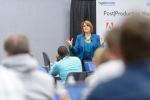
Photo by Gabriel Benois, Unsplash
Brands deliver value. To customers (a consistency of brand promise, or “knowing what you’ll get”). To shareholders (increased revenues, a shorter sales/conversion cycle). To employees (motivated and brand-engaged employees have less turnover, higher satisfaction, and deliver better on KPI’s).
So if the ROI of good branding is so high, why is it always so hard to keep the brand at the center of strategic focus? One simple reason is cost. If the opportunity cost of NOT branding effectively or efficiently isn’t factored in, decision-makers often think it is too expensive to expend time and financial resources on brand-building exercises. Here are four strategies that are cost-effective ways to keep your brand alive and well.
1. Mine Your Own Content
A tool everyone has, but rarely maximizes is your own media library. Maybe because it’s not so much a library as a mish-mash of files that are not indexed, so no one can find them. Every graphic, photograph, video clip, newsletter article or blog post you and your team have created are already sunk costs. Properly archived and tagged with metadata, they can be repurposed and reused in multiple ways to put your brand front and center with customers, clients, employees and other stakeholders. The key is to use a DAM (digital asset management system) or MAM (media asset management system–often for larger files like video and audio) and build workflow best practices into every time you create a digital asset. Create a consistent system that works for everyone in your organization, with anywhere anytime access–vital with teleworking–is essential, so that you can build and share branded content that everyone can access, not only the intern, editor or photographer who first created it. A photo DAM system can help you avoid those awful automatic names (IMG_001) for photos, for example, by batch renaming name on ingest. But always maintain the original name in the data. Adobe Bridge, Google Photos (heads up–free is over June 2021!) and Adobe Lightroom are tools for managing photo content. LuminarAI is out in Beta from Skylum* and has a number of great photo management tools built into its AI-powered creative engine. For video, there are a number of DAMs (digital asset management) systems out there–from Imagen to CATdv by Squarebox. (If you are looking for a MAM, this is a handy guide.) There are also brand-specific systems, designed specifically for the marketing department (as opposed to a video production company or broadcaster) such as Brandfolder, Bynder, and Cloudinary.
- Bottom Line: If you can’t find it, you can’t use it. So whether you use a sophisticated archiving system or a spreadsheet, save money and create your own “stock” library of branded content to tell your organization’s story.
*disclaimer: I do some writing and marketing work for Skylum. I do not receive any fees related to sales.
2. Video Sells
According to IndieGogo, “Crowdfunding pitches with video content raise 112% more than those without.” Video certainly is one of the top-most searched items on the web. But producing a branding video in-house can be daunting. It’s a time-consuming process, and commissioning one to be made can be costly. With just the investment in a Zoom H4N digital audio recorder, a SONY FDR-AX100 4K Ultra HD video camcorder, and some basic audio recording/mixing software like Blackmagic Design’s DaVinci Resolve, you can quickly share useful branded video clips to your target audience. Or consider building your community by sharing useful content with a podcast. For a quick rundown on the latest podcasting software, check out this review.
- Bottom Line: Build video into your brand strategy. It works.

Photo by Sam Mcghee, Unsplash
3. Show Not Tell
So many people want to say WHAT it is they do, before really explaining HOW and WHY they do it. This is the core of your brand, and that’s the story you want to tell through any platform, whether it is a speaking engagement, podcast, blog post, or branded video. BTS, or “Behind the Scenes”, is some of the top-shared content online. Why? Because as humans we are naturally curious and love to know what makes things work. So build “How to” or “How we made that” into every production or project. That means adding a BTS camera. At the low end, could be a mobile phone. But for under $300 you could add a LOT of quality and pizzazz with a tool like the 4K DJI Osmo Pocket Gimbal Camera. Or if that’s too pricey, throw your mobile phone onto a gimbal with this little number, also from DJI. In a future post I’ll talk about good lighting and sound.
- Bottom Line: Make shooting and sharing BTS part of your brand best practices.

DJI Pocket Osmo Camera in action
4. Email Signature is Free Branded Space
Lately, most of my incoming emails from systems like MailChimp and Constant Contact are going into my Spam and Promotions folders. So those are lost efforts to convey branded content. Why not supplement those efforts through a free space your contacts see every day: your e-mail signature. What a great opportunity to do a little brand storytelling! A signature line doesn’t just give you a chance to tell your name and title, it gives you space for a blog link, twitter hashtag for an upcoming event, or YouTube link to your latest video. This simple free advertising can be employed unilaterally—and uniformly–across your organization. (Send a “signature of the week” email to everyone in your organization with easily copied information and links.)
- Bottom Line: Creating an email signature strategy builds brand awareness for free.
Using these four strategies, you can gain ground with your brand, and decrease the cost of creating or trying to find existing content to share with your audience. More story. Less hassle. And that adds to your brand ROI.
Amy DeLouise is a video and virtual event producer, brand strategist, author and speaker.





 If you’ve been following the #GalsNGear hashtag on Twitter, then you know I’ve been working behind the scenes with many colleages–male and female–across production and post to put the focus on women in the technical fields of our industry. We want to be sure these professionals get the limelight they deserve, get access to the best gear, and also help bring along the next generation of women across the industry.
If you’ve been following the #GalsNGear hashtag on Twitter, then you know I’ve been working behind the scenes with many colleages–male and female–across production and post to put the focus on women in the technical fields of our industry. We want to be sure these professionals get the limelight they deserve, get access to the best gear, and also help bring along the next generation of women across the industry.  Several hundred folks attended our most recent VR, production and post gear demos, and enjoyed our killer panel with women in film finance, VR, cinematography, and film finishing during NAB New York (shout-out to our partners NAB, Adorama and Black Magic Design). I’m looking forward to seeing friends and colleagues at IABM in London this weekend, and at NAB Vegas this spring. If you’ve got an idea for a #GalsNGear pop-up event at an industry gathering or film festival near you, give me a shout.
Several hundred folks attended our most recent VR, production and post gear demos, and enjoyed our killer panel with women in film finance, VR, cinematography, and film finishing during NAB New York (shout-out to our partners NAB, Adorama and Black Magic Design). I’m looking forward to seeing friends and colleagues at IABM in London this weekend, and at NAB Vegas this spring. If you’ve got an idea for a #GalsNGear pop-up event at an industry gathering or film festival near you, give me a shout.






